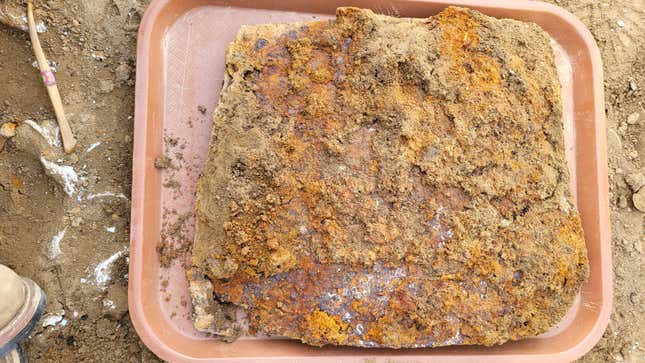Colonial Armor Found in 17th-Century Maryland Cellar
Archaeologists working on the site of a colonial fort in Maryland found a concave, near-rectangular metal scrap that they say was once a part of a colonial armor set.
The metal piece was an iron tasset, the archaeologists determined, which would have hung from a breastplate to protect the wearer’s thighs. It was found in Historic St. Mary’s City, the first capital of colonial Maryland and the site of ongoing excavations into America’s colonial past.
The archaeological team has been excavating St. Mary’s Fort, a structure built in 1634 and considered Maryland’s earliest colonial site, since 2020. The armor piece was covered in mud, but X-ray images revealed steel bands and rivets that decorated the piece and held it together.
“Given the early context of the tasset’s discovery (ca. 1634-early 1640s), it is most likely that it was brought from Europe,” said Travis Parno, Historic St. Mary’s City’s director of research and collections, in an email to Gizmodo. “There was a limited amount of blacksmithing occurring in St. Mary’s City during that time frame.”
“Given the fact that this tasset and another found previously at St. Mary’s City were both discarded, it is most likely that tassets were being brought across the Atlantic, deemed unnecessary, and discarded,” Parno added.
The tasset was recovered from the cellar of “Structure 101,” the first storehouse in Maryland. So far, about 20% of the cellar associated with the storehouse has been excavated. According to the Washington Post, the excavations have also turned up decorative metal braiding, a pair of colonial-era scissors, and the outline of a large building that was built shortly after the colonists arrived on Maryland’s shores.
Parno said that excavations at the fort are expected to continue through the next decade, but thankfully you won’t have to wait that long to see results: The excavation site itself will be viewable through one of the Historic St. Mary’s City tours.
More: 1,000-Year-Old Precursor to Stainless Steel Found in Iran, Surprising Archaeologists
Archaeologists working on the site of a colonial fort in Maryland found a concave, near-rectangular metal scrap that they say was once a part of a colonial armor set.
The metal piece was an iron tasset, the archaeologists determined, which would have hung from a breastplate to protect the wearer’s thighs. It was found in Historic St. Mary’s City, the first capital of colonial Maryland and the site of ongoing excavations into America’s colonial past.
The archaeological team has been excavating St. Mary’s Fort, a structure built in 1634 and considered Maryland’s earliest colonial site, since 2020. The armor piece was covered in mud, but X-ray images revealed steel bands and rivets that decorated the piece and held it together.
“Given the early context of the tasset’s discovery (ca. 1634-early 1640s), it is most likely that it was brought from Europe,” said Travis Parno, Historic St. Mary’s City’s director of research and collections, in an email to Gizmodo. “There was a limited amount of blacksmithing occurring in St. Mary’s City during that time frame.”

“Given the fact that this tasset and another found previously at St. Mary’s City were both discarded, it is most likely that tassets were being brought across the Atlantic, deemed unnecessary, and discarded,” Parno added.
The tasset was recovered from the cellar of “Structure 101,” the first storehouse in Maryland. So far, about 20% of the cellar associated with the storehouse has been excavated. According to the Washington Post, the excavations have also turned up decorative metal braiding, a pair of colonial-era scissors, and the outline of a large building that was built shortly after the colonists arrived on Maryland’s shores.
Parno said that excavations at the fort are expected to continue through the next decade, but thankfully you won’t have to wait that long to see results: The excavation site itself will be viewable through one of the Historic St. Mary’s City tours.
More: 1,000-Year-Old Precursor to Stainless Steel Found in Iran, Surprising Archaeologists
